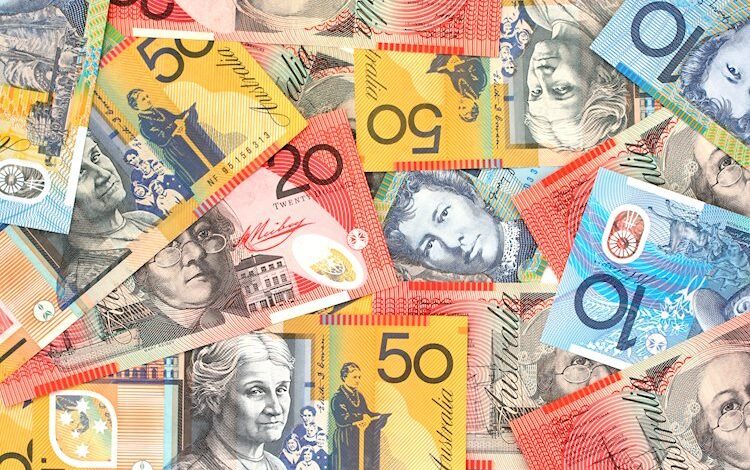AUD/USD remains on the defensive around 0.6500, eyes on US PMI data

The AUD/USD pair trades on a weaker note around 0.6505 during the early Asian session on Monday. The downbeat Australia’s Judo Bank Services Purchasing Managers Index (PMI) weighs on the Aussie. Investors await the US ISM Services PMI ahead of the Reserve Bank of Australia (RBA) interest rate decision on Tuesday.
Dada released on Friday showed that the US Nonfarm Payrolls (NFP) increased by 114K in July from the previous month of 179K (revised down from 206K). This figure came in weaker than the expectation of 175K, according to the US Bureau of Labor Statistics (BLS).
Meanwhile, the US Unemployment Rate rose to 4.3% in July from 4.1% in June, the highest level since November 2021. The Average Hourly Earnings eased to 0.2% month-over-month in the same reported period, below the market consensus of 0.3%. On an annual basis, the figure decreased to 3.6% from the previous reading of 3.8%.
The weaker-than-expected US employment data on Friday, along with the dismal ISM Manufacturing PMI report on Thursday, have fuelled the expectation that the US Federal Reserve (Fed) would cut its interest rate in September. This, in turn, might exert some selling pressure on the US Dollar (USD) in the near term.
On the Aussie front, the upside of the Aussie Dollar (AUD) is limited by diminishing expectations for another rate hike by the RBA at its policy meeting on Tuesday. Traders have priced in nearly 80% odds of an RBA rate cut by year-end.
The latest data by Judo Bank and S&P Global on Monday revealed that the final reading of Australia’s Judo Bank Services PMI dropped to 50.4 in July, This figure was below the consensus and the previous reading of 50.8. The Composite PMI declined to 49.9 in July versus 50.2 prior.
Australian Dollar FAQs
One of the most significant factors for the Australian Dollar (AUD) is the level of interest rates set by the Reserve Bank of Australia (RBA). Because Australia is a resource-rich country another key driver is the price of its biggest export, Iron Ore. The health of the Chinese economy, its largest trading partner, is a factor, as well as inflation in Australia, its growth rate and Trade Balance. Market sentiment – whether investors are taking on more risky assets (risk-on) or seeking safe-havens (risk-off) – is also a factor, with risk-on positive for AUD.
The Reserve Bank of Australia (RBA) influences the Australian Dollar (AUD) by setting the level of interest rates that Australian banks can lend to each other. This influences the level of interest rates in the economy as a whole. The main goal of the RBA is to maintain a stable inflation rate of 2-3% by adjusting interest rates up or down. Relatively high interest rates compared to other major central banks support the AUD, and the opposite for relatively low. The RBA can also use quantitative easing and tightening to influence credit conditions, with the former AUD-negative and the latter AUD-positive.
China is Australia’s largest trading partner so the health of the Chinese economy is a major influence on the value of the Australian Dollar (AUD). When the Chinese economy is doing well it purchases more raw materials, goods and services from Australia, lifting demand for the AUD, and pushing up its value. The opposite is the case when the Chinese economy is not growing as fast as expected. Positive or negative surprises in Chinese growth data, therefore, often have a direct impact on the Australian Dollar and its pairs.
Iron Ore is Australia’s largest export, accounting for $118 billion a year according to data from 2021, with China as its primary destination. The price of Iron Ore, therefore, can be a driver of the Australian Dollar. Generally, if the price of Iron Ore rises, AUD also goes up, as aggregate demand for the currency increases. The opposite is the case if the price of Iron Ore falls. Higher Iron Ore prices also tend to result in a greater likelihood of a positive Trade Balance for Australia, which is also positive of the AUD.
The Trade Balance, which is the difference between what a country earns from its exports versus what it pays for its imports, is another factor that can influence the value of the Australian Dollar. If Australia produces highly sought after exports, then its currency will gain in value purely from the surplus demand created from foreign buyers seeking to purchase its exports versus what it spends to purchase imports. Therefore, a positive net Trade Balance strengthens the AUD, with the opposite effect if the Trade Balance is negative.



